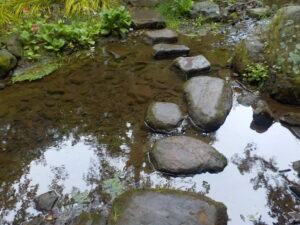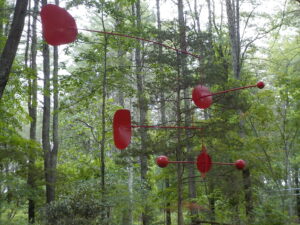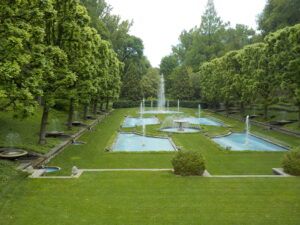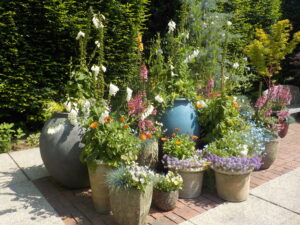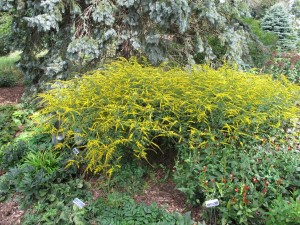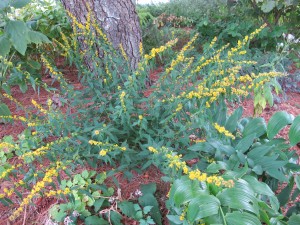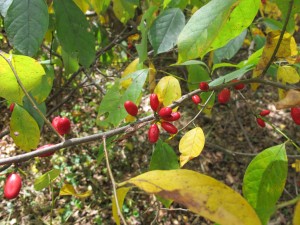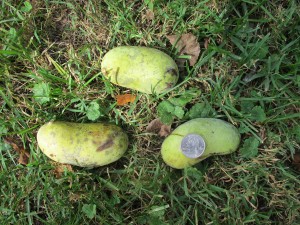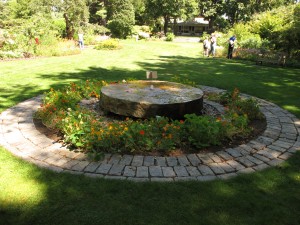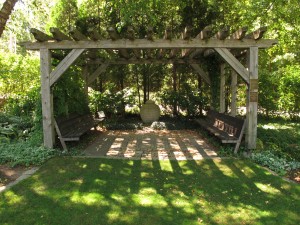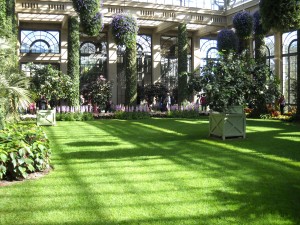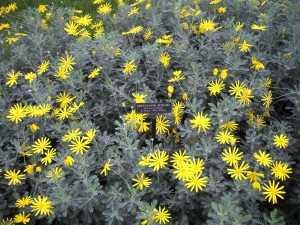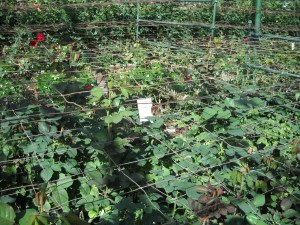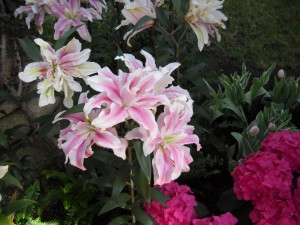Learning from Other Gardens
All these gardens had significant areas of lawn or meadow. I realize that lawns are not in favor, generally, among the pro-pollinator and bird crowd. But if you provide plenty of plants that support pollinators, I do not see lawns as bad. Each of these gardens has plenty of flowering trees, shrubs, perennials and annuals. Something is always in bloom, including both native plants and exotic ones.
Bedrock Garden only recently was deeded over from the original owners, Jill Nooney and Bob Munger, to the non-profit that manages the property. Jill is an amazing sculptor who for over 30 years has created art to surprise and delight visitors to this 20 acre garden. Much of her art is painted welded steel that will delight visitors for the century ahead. She is the modern Alexander Calder of gardens.
All three of the gardens I visited made much use of water in the landscape. I am lucky enough to have a small stream that runs by my gardens. I built a bench near it, so I can listen to the burble of the water. And you can tune your brook: Place stones that hold back water, allowing it to cascade over them. Different drops create different sounds.
Great gardens like those at Longwood, an old DuPont family residence originally, recognize that color is important all year. But most shrubs and perennials only bloom for a few weeks. So they choose trees and shrubs that are not only sculptural in form, but have also have nuanced colors in their leaves. Green is not one color, but many. Choose wisely.
Learning on the Road
I’m not much of a country music fan, but do love Willy Nelson’s “On the Road Again” – probably because I love to travel. Recently I’ve been on the road again, visiting friends and family in Pennsylvania and Ohio, traveling by car. Unlike Willy, it’s not the honkytonks or making music that interests me, it’s the public gardens, garden centers and private gardens. There is always something to learn.
While in Pennsylvania I visited Longwood Gardens in Kennett Square. These are at the home of the late Pierre S. Dupont which have been open to the public since the 1920’s. The gardens are largely formal, with huge expanses of lawn, fountains, shaped hedges and trees, ancient tulip poplars, displays of perennials, annuals, wonderful long shaded walkways, experimental plots and even a vegetable garden. A new addition is an 86-acre meadow, allowed to grow up in wild plants including many called weeds by gardeners. Right now dominant species include golden rods, fall asters and tall grasses.
Meanwhile, at the home of friends nearby, I spent time in a smaller version of the Longwood Meadow. Lisa and Chris Brinton bought a run-down farm about 30 years ago and have been working on it ever since. For the past decade that included bringing back to life a few acres of field that had been farmed for corn until the soil was depleted. When they bought the place the soil was so poor that even weeds had a hard time growing.
What struck me about their meadow was the number of bees, birds and butterflies. The field had been allowed to grow up in milkweed, goldenrod and native grasses. Trees that attract wildlife had been planted or allowed to colonize. It was a slow process as they didn’t bring in new topsoil, they just allowed leaves and grasses to decompose where they landed each fall and winter. Slowly the land came back to life. Mother Nature was allowed to reclaim the land.
Goldenrod gets a bad rap from most gardeners, but there are some varieties that are well mannered and beautiful at this time of year. I visited North Creek Nursery in Landenberg, Pennsylvania .This wholesale nursery grows hundreds of kinds of native plants, including half a dozen different kinds of goldenrod. Unlike the 5 to 6 foot giants that try to muscle their way into my gardens, they had some nice smaller varieties of goldenrod that I plan to grow.
Among their goldenrods there is an 18 to 36-inch tall shade-loving goldenrod, Solidago caesia, that I grew for some years before it was weeded out by a well-meaning helper. It’s hardy to Zone 4 and it thrives in dry shade. The small blossoms appear all the way up the stems. I also loved ‘Fireworks’ (a variety of Solidago rugosa). It stands about 3 feet tall, and prefers average to moist soils in full sun to half shade. Its blossoms are distributed along the stems, which arch out from this clump-forming perennial.
Of the various ornamental grasses I saw in the trial gardens at North Creek, my favorite was a little blue stem (Schizachyrium scoparium) called ‘Standing Ovation’. It is a North Creek introduction that is said to stand up well all year and at this time of year is a handsome reddish purple. It is hardy to Zone 3, meaning it will survive even our coldest winters.
Visiting friends in Athens, Ohio I liked the way my friends had terraced their gardens – without spending a fortune. Stone walls are great for creating terraces, but many of us cannot afford to make the investment. My friends used cement blocks that came with faux-stone fronts. The blocks stack nicely and lay flat, and hold back the soil to create level gardens. I have never worked with landscape blocks of this sort, but see that they are a good building material that is easier to work with than the irregular sizes and shapes of real stone.
Also in Ohio I saw spicebush (Lindera benzoin), a native understory shrub that has flavorful leaves and seeds. At the farmers market in Athens I bought some dried leaves for tea, and then saw it growing in the woods at my friends’ house. The bright red berries are very attractive right now, and I am told they can be used to flavor gin or as a substitute, dried and ground, for allspice. Birds love the seeds, robins in particular, and strip the berries in the fall when other foods become scarcer. Spicebush is a favorite food plant of two butterflies: the spicebush swallowtail and the promethea silkmoth. Spicebush is hardy to zone 4, and I definitely want to plant one.
In both Ohio and Pennsylvania I got to eat the fruit of the pawpaw tree (Asimina triloba). Pawpaw is a native fruit tree with fruit that is flavored somewhat like a cross between a banana and a mango. The flesh is mushy, and seeds are large. It is hardy to Zone 4, though not commonly grown in New England. I got a couple of small pawpaw trees early this summer, and one day maybe I’ll get fruit from my own trees.
Being a serious gardener means wherever I go I’ll have something interesting to see – and learn about.
Henry is the author of 4 gardening books. His Web site is www.Gardening-Guy.com. Contact him at henry.homeyer@comcast.net.
Designing a Garden, and Expanding Your Plant Palette
Want to have a spectacular flower garden? Nothing beats visiting a good garden when it comes to learning how to make your own better. I recently visited Kirkwood Garden on Rte 3 in Holderness, NH. I had visited it last spring when I was invited to speak at the Squam Lakes Natural Science Center. I was bowled over by the plant diversity, the beauty of the layout, and the tranquility of the garden. But I didn’t have my camera and notebook, so I went back in August and was once again delighted – and instructed – by the garden.
It is easy to look at a professionally designed and maintained garden and say, “I could never do that.” And for many gardens that’s true. Longwood Gardens in Pennsylvania or the Brooklyn Botanical Gardens encompass dozens of acres and are maintained by teams of workers year round. But Kirkwood Garden is less than an acre (in my estimation) and I’m told it is maintained by a single gardener. And it has not been around for decades. It was installed in 1996 – largely by volunteers, and with many donated plants.
So what pleases me so much about this garden? First is the overall design and layout. If you walk down three broad stone steps, you are on a large central lawn – but one that is carved up and delineated by curved flower beds, islands and walkways that head off to shady nooks. No straight lines here. I like that. And there are places to sit, with nice 2-foot square flagstones laid out in front, so that dozens of daily feet will not create bare spots. And there are shady places as well as sunny places to sit.
Each bed is backed by shrubbery, with the tallest plants towards the back. When I visited in spring, the rhododendrons, azaleas and mountain laurels were in bloom. Many different varieties, each with a different color and slightly different bloom time. Now there is summersweet clethra (Clethra alternifolia) with its intense sweet blossoms, and a lovely viburnum (Viburnum sieboldii) loaded with red berries held upright on bright yellow stems.
Also in the back of the beds – and blooming now – are many tall perennials. I grow and love snakeroot (also called bugbane, but technically Cimicifuga racemosa). But instead of a couple of plants, someone has planted many, or allowed them to spread over the 17-year life of the garden. I tend to have many varieties of plants inter mingled. They have many large stands of a single species, which makes a bold design statement.
A tall fall plant I have only tried once, and not found to be worth keeping, is Boltonia (Boltonia asteroides). They selected a variety called ‘Snowbank’, which my reference text tells me is unlike most boltonias, in that it is self supporting. It is 3-5 feet tall at Kirkwood and stands up without support, while the generic boltonia I tried was 5-6 feet tall and flopped over. At Kirkwood it has formed a cluster about 8 feet wide and 5 feet across and each stem supports a very small white daisy-like blossom. I shall try again.
Speaking of flopping, some annuals (purple cone flower, for one) were supported by horizontal grids of wire. Green wire mesh with 2 inch openings was supported on bamboo stakes about 18 inches off the ground (parallel to the ground) allowing stems to grow through the wire,. The wire was unobtrusive and kept the tall flowers from flopping. Very clever – but will I remember to do that next spring? And will you?
An unusual fall bloomer at Kirkwood, which I have only rarely seen used, is yellow waxbells (Kirengeshoma palmata). This is a shade loving perennial with large maple-looking leaves and large yellow flowers. I have to admit it is slug bait, for me, but on a good year it can be a wonderful addition to a shady garden in the autumn. It is technically only hardy to Zone 5 (minus 20 in winter) but it has survived colder temperatures in my garden.
I learned there that the gorgeous bright red cardinal flower (Lobelia cardinalis) will survive in ordinary garden soil – not just in wet places (which is where it grows in the wild, and where I have it in my garden). Just plant in with some afternoon shade. I shall try that, too.
What else did I like about Kirkwood Gardens? It has maps everywhere, which although initially difficult to figure out, actually work quite well. You can learn the names of lots of different plants, annuals, perennials and woodies. And the garden is open year round and free to all. Donations are gratefully accepted. So you can visit often and see how special plants look in the different seasons.
Last of all, I agree with Barbara Gillan of Stillwater, N.J, who I met while admiring the garden. She and her family visit every year and remarked, “It’s a great place to go when you want to daydream.”
Henry’s web site is www.Gardening-guy.com. His newest book is a fantasy-adventure for children, Wobar and the Quest for the Magic Calumet.
Visiting Longwood Gardens in Winter
I recently traveled to Pennsylvania to visit family, and while there I visited Longwood Gardens in Kennett Square, PA (about 30 miles west of Philadelphia). It was a fabulous break from winter and a good chance to see flowers in bloom before the flower show season gets into full swing. From now through March 24 their 4 acres of glass conservatory are displaying more than 5,000 orchids – and much more.
I’ve been to many greenhouses over the past few decades, both here in the States and in Europe. Often I find them too hot and too humid, particularly if dressed in winter clothing. The Longwood Garden conservatory seems to have figured out how to do it right. The greenhouses were built in the 1920’s for Pierre du Pont (1870-1954), who, it would appear, had more money than he knew what to do with. So these greenhouses have very high ceilings, about 50 feet in places. That means that hot sticky air can accumulate near the ceiling, leaving us mortals on the ground with warm, pleasant air.
Walking into the main halls of the conservatory one is greeted with a massive arrangement of potted orchids made to look like cut orchids in a huge vase. It was an arrangement of whites and yellows, two different kinds, standing in a shallow pool of water. Light poured in everywhere through the ceiling and walls. To your left, a lawn! That’s right, a perfectly manicured lawn big enough to host a generous game of croquet! In this season, it was a refreshing sight.
I like the fact that all the plants are labeled (which is mostly true, outside the conservatory, too). I carry a notebook so that I can research plants I like – not all are suitable for New England. I loved a yellow daisy-like plant with blue gray foliage, called Grey-leafed Euryops (Euryops pectinatus). Unfortunately, it is a South African shrub suited for California, or indoors, but not my garden.
I observed a euphorbia (Euphorbia tirucalli) ‘Sticks on Fire’ that I simply must find, and accept that it must stay in a pot that will allow me to bring it in during the winter. It has miniscule leaves, but the stems are yellow, progressing to red toward the tips of the plant. It is very dramatic, and would be a nice houseplant. My nine-year old grandson, George, collects succulents, and this would be a great addition to his collection.
Speaking of kids, Longwood Gardens is definitely child-friendly. In one section docents were handing out plastic-coated cards with plant pictures for a scavenger hunt for kids, and there is a nice water feature that will allow kids to get a little wet, but not soaked. And the moving squirts of water are definitely exciting. Docents are everywhere, and very helpful. One was showing children vanilla pods that were picked from a very long viney vanilla orchid (Vanilla plainifolia), and allowing them to sniff the vanilla scent. The plant fascinated me – nearly 25 feet tall with fleshy green leaves, it had been in the conservatory only since 2010.
In that same room with the vanilla plant were examples of orchids of every hue, from bright red to purple to orange and yellow to white. I was amazed to see each in perfect condition, no spent blossoms or droopy leaves. Then I learned from the docent in the room that these potted orchids are changed out 2 to 3 times a week. Only perfection is on display!
I like to learn from each garden I visit. One new growing trick that I liked involved using standard sheep fence to hold up flowers. But instead of running the fencing vertically, as is standard, three layers of fencing were stretched between cross bars horizontally. The first bar was about 2 feet off the ground, the next at 3 feet, and a top layer at 4 feet. Those supports were about 15 feet apart. This support system allowed floppy roses to grow through the 6-inch openings of the fencing, and to lean on the wires as needed – without being tied up. This would work well for any type of tall flower outdoors that might get beaten down by the rain.
Also of interest to me was a rose variety called ‘Pink Cherokee’ that was planted in the conservatory in the 1920’s when it was first built. The rose is a simple single rose that has climbed more than 20 feet up and blooms (in the greenhouse) in spring, summer and winter.
The greenhouses included many standard flowers besides the orchids: daffodils, tulips, freesias, oriental lilies (including a double one, ‘Double Star’, with twice the number of petals). I loved seeing some rare yellow clivia – I grow the standard orange one, a real work horse of a house plant with glossy long strap-like leaves. The yellow one I had heard of, but never seen.
For more information on the Longwood Gardens, go to their web site, www.longwoodgardens.org. Admission is $18for adults, $15 for seniors (62+), and $8 for students 5-18. If you are in Pennsylvania, the gardens are worthy of a visit in any season – the outdoor gardens in summer are fantastic!
Henry Homeyer can be reached at henry.homeyer@comcast.net or PO Box 364, Cornish Flat, NH 03746. Visit his web site at www.Gardening-guy.com.



